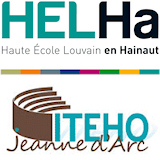Centre de Documentation HELHa Tournai - Mouscron
Heures d'ouverture (période scolaire)
| Tournai | Mouscron |
- lundi : 9h00-12h00 et 13h00-17h00
- mardi: 9h00-12h30 et 13h00-17h00
- mercredi: 9h00-12h30 et 13h00-17h30
- jeudi: 9h00-12h30 et 13h00-17h00
- vendredi: 09h00-17h00
| - lundi: 9h00 à 12h30 et 13h00 à 17h15
- mardi: 13h00 à 17h15
- mercredi: 13h00 à 17h15
- jeudi : 13h00 à 17h15
- vendredi: 13h00 à 17h00 |
Après identification sur connected (ID et mot de passe), les membres de la Helha ont l'accès à Cinahl et à Cairn en passant par l'onglet "Bases de données" de ce catalogue et en cliquant sur le lien d'accès.
Semaine du 12/05 à Tournai : Horaire habituel.
Semaine du 19/05 à Tournai : Horaire habituel.
Semaine du 26/05 à Tournai : Fermé le jeudi 29/05 (Ascension).
Semaine du 12/05 à Mouscron : Horaire habituel
Semaine du 19/05 à Mouscron : Horaire habituel. Horaire habituel
Semaine du 26/05 à Mouscron : Fermé le jeudi 29/05 (Ascension).
Notre catalogue possède un thésaurus (voir ci-dessous : catégories). Pour effectuer une recherche structurée, nous vous conseillons de cliquer sur la "recherche multi-critères". Dans le menu déroulant, descendez et choisissez "Indexations - Catégories", tapez votre descripteur (mot-clé) et sélectionnez-le lorsqu'il apparaît. Pour introduire un 2è terme, renouvelez l'opération (ET). Vous pouvez élargir les résultats en ajoutant des termes proches avec + (OU).

[article]
| Titre : |
Ozonized water as an alternative to alcohol-based hand disinfection. |
| Titre original : |
L’eau ozonée, une alternative à la désinfection des mains par un produit hydro-alcoolique ? |
| Type de document : |
texte imprimé |
| Auteurs : |
Joseph Hajjar, Auteur ; Philippe VANHEMS, Auteur ; Olivia Keita-Perse, Auteur |
| Année de publication : |
2020 |
| Article en page(s) : |
231-234 |
| Langues : |
Français (fre) |
| Catégories : |
Alpha
B:Bactérie ; D:Désinfection ; H:Hygiène des mains ; M:Micro-organisme ; S:Solution hydroalcoolique ; V:Virus
|
| Résumé : |
Background. Hand hygiene plays a vital role in the prevention of transmission of microorganisms. Ozone (O3) is a highly reactive gas with a broad spectrum of antimicrobial effects on bacteria, viruses, and protozoa. It can easily be produced locally in small generators, and dissolved in tap water, and quickly transmits into ordinary O2 in the surrounding air. Aim. To compare ozonized tap water and alcohol rub in decontamination of bacterially contaminated hands. Methods. A cross-over study among 30 nursing students. Hands were artificially contaminated with Escherichia coli (ATCC 25922), then sanitized with ozonized tap water (0.8 or 4 ppm) or 3 ml standard alcohol-based rub (Antibac 85%). The transient microbes from fingers were cultivated and colony-forming units (cfu)/ml were counted. The test procedure was modified from European Standard EN 1500:2013. Findings. All contaminated hands before disinfection showed cfu >30,000/ml. The mean (SD) bacterial counts in (cfu/ml) on both hands combined were 1017 (1391) after using ozonized water, and 2337 (4664) after alcohol hand disinfection. The median (range) values were 500 (0-6700) and 250 (0-16,000) respectively (non-significant difference). Twenty per cent of participants reported adverse skin effects (burning/dryness) from alcohol disinfection compared with no adverse sensations with ozone. Conclusion. Ozonized tap water is an effective decontaminant of E. coli, and it could be an alternative to traditional alcohol-fluid hand disinfectants both in healthcare institutions and public places. Ozonized water may be especially valuable for individuals with skin problems. |
| Permalink : |
http://cdocs.helha.be/pmbtournai/opac_css/index.php?lvl=notice_display&id=45014 |
in Hygiènes > Vol 28 - N°4 (Septembre 2020) . - 231-234
[article] Ozonized water as an alternative to alcohol-based hand disinfection. = L’eau ozonée, une alternative à la désinfection des mains par un produit hydro-alcoolique ? [texte imprimé] / Joseph Hajjar, Auteur ; Philippe VANHEMS, Auteur ; Olivia Keita-Perse, Auteur . - 2020 . - 231-234. Langues : Français ( fre) in Hygiènes > Vol 28 - N°4 (Septembre 2020) . - 231-234
| Catégories : |
Alpha
B:Bactérie ; D:Désinfection ; H:Hygiène des mains ; M:Micro-organisme ; S:Solution hydroalcoolique ; V:Virus
|
| Résumé : |
Background. Hand hygiene plays a vital role in the prevention of transmission of microorganisms. Ozone (O3) is a highly reactive gas with a broad spectrum of antimicrobial effects on bacteria, viruses, and protozoa. It can easily be produced locally in small generators, and dissolved in tap water, and quickly transmits into ordinary O2 in the surrounding air. Aim. To compare ozonized tap water and alcohol rub in decontamination of bacterially contaminated hands. Methods. A cross-over study among 30 nursing students. Hands were artificially contaminated with Escherichia coli (ATCC 25922), then sanitized with ozonized tap water (0.8 or 4 ppm) or 3 ml standard alcohol-based rub (Antibac 85%). The transient microbes from fingers were cultivated and colony-forming units (cfu)/ml were counted. The test procedure was modified from European Standard EN 1500:2013. Findings. All contaminated hands before disinfection showed cfu >30,000/ml. The mean (SD) bacterial counts in (cfu/ml) on both hands combined were 1017 (1391) after using ozonized water, and 2337 (4664) after alcohol hand disinfection. The median (range) values were 500 (0-6700) and 250 (0-16,000) respectively (non-significant difference). Twenty per cent of participants reported adverse skin effects (burning/dryness) from alcohol disinfection compared with no adverse sensations with ozone. Conclusion. Ozonized tap water is an effective decontaminant of E. coli, and it could be an alternative to traditional alcohol-fluid hand disinfectants both in healthcare institutions and public places. Ozonized water may be especially valuable for individuals with skin problems. |
| Permalink : |
http://cdocs.helha.be/pmbtournai/opac_css/index.php?lvl=notice_display&id=45014 |
|
Exemplaires (1)
|
| T008814 | HYG | Revue | Tournai | Soins infirmiers (T) | Disponible |







